Roberto Vacca
Web Site

GLOBAL WARMING, GREENHOUSE EFFECT, FUTURE CLIMATE: A CRITICAL ANALYSIS, by Roberto VACCA, M!ND, August 2005
[Roberto Vacca is not a climatologist. He is a system engineer and he has tried to understand who is right among so many disagreeing experts]
The carbon dioxide (CO2) content of the atmosphere is growing. In 1958 it was of 315 ppm (parts per million), that is a total of 670 Gt (billion tons) of carbon; in 2004 it was 377 ppm (798 Gt). For the past 30 years we have heard again and again the warning:
"The increase in atmospheric CO2 boosts the greenhouse effect and is causing a dangerous global warming of the Earth."
Certain scientists (among whom J.E. Hansen, NASA, D.A. Lashhof, Environment Protection Agency USA (EPA) forecast that the average temperature of our atmosphere will increase of 4 or 5°C in the next 50 years. Then huge masses of ice would melt in Antarctica and in Greenland so that the level of the oceans would go up. They contend that in the last century it has already grown of 10 centimeters. There appears to be a fairly wide consensus that atmospheric CO2 increases because we burn fossil fuels (coal, oil, methane). If we don't limit drastically the gas emissions - they say - the process will be accentuated. At the end of this century the level of the seas will be a few meters higher: coastal cities will be submerged. John T. Hardy ( Climate Change, Wiley, 2003) reports experts opinions tonthe effect that the imminent rising of the sea level of one meter will flood tens of thousand square kilometers on the coasts of America, Europe, Asia, Africa, forcing the migration of millions.
This point of view tends to be considered as an official established truth. It is embodied in the Protocol signed in Kyoto in 1997 and ratified by the governments of 150 Countries. These Countries produce jointly about 60% of all the carbon dioxide released in the atmosphere. The goal of the Protocol is to decrease CO2 emissions so that by 2012 their level will be 7% less than that of 1990. The Kyoto Protocol has been ratified by Russia, but not by the USA who consider that it would have an adverse effect on their economy. To implement it, they would have to enforce measures aimed at increasing efficiencies, limiting energy use, adopting renewable sources of energy, diversifying technologies. They contend that the adoption of Kyoto rules would cause the loss of 5 million jobs and a decrement of the gross domestic product: 62 G$ at 2010 and 102 G$ at 2020. These amounts represent roughly 1% of the US GDP, but still they are considered unacceptable.
It's curious that these theories have been accepted so widely, since only 15% of the greenhouse effect is caused by CO2 (the predominant factor is water vapor and also methane has a marked impact). This is an important issue: are we really facing a serious risk? Opinions differ. The prophets of doom and their antagonists (according to whom human actions have next to no impact on global climate) engage in debate on newspapers, on TV and in harsh political confrontations. Thousands of them sign manifestos and they publish virulent comments stating that their opponents' documents are signed by less numerous and less qualified individuals. Let us look now at the history of the various theories on the subject. Then I will analyze the numbers, the experimental evidence and the theories too.
The story of the greenhouse effect and of the Earth's climate is full of brilliant intuitions and also of wrong calculations - and of correct ones. Paradoxically a wrong forecast was expressed by John von Neumann, the famous mathematician of Hungarian origin, in front of whom Dennis Gabor (the physicist who was awarded the Nobel Prize for the invention of holography) said he felt like the village idiot. [von Neumann worked out complex mathematical theories, made important discoveries and also defined the structure of the first computers: the JOHNNIAC, built at Princeton was named in his honor]. Von Neumann also produced the theory of global climate models, later called GCM or General Circulation Models. In these the whole atmosphere is subdivided in tens of thousand elementary cells. Then the mechanic and thermodynamic mutual impacts are computed, aiming to foresee all future meteorological events. It is an intertesting approach and it is currently used to forecast the weather many days in advance. The models, though, are inadequate to provide long term forecasts. In 1955 von Neumann contended that this was due to the insufficient speed of the comouters then available. He anticipated that in 1980 computers would be so fast to allow weather forecasting months or perhaps years in advance. At present computers are millions of times faster than he had expected - but still we cannot produce long term weather forecasts. The processes involved depend on a vast multitude of factors in ways that are yet to be clarified. Correct calculations are carried out and they are showing which points of view are more reasonable concerning past and future climate variations. So we are reaching scarce certitudes and we are facing debatable issues.
The French physicist and mathematician Fourier was the first to formulate the mathematical theory of heat transmission. He also discovered the mathematical series (named afte him) needed to analyze all periodic processes (including climate variations as we will see). In 1824 he was also the first to understand that the atmosphere produces a greenhouse effect on our planet: energy irradiated by Earth toward space is less than that received by the sun's radiation (which has a shorter wavelength). If there was no atmosphere, there would be no greenhouse effect and the average temperature of the Earth's surface would be lower by 18°C than the present one (which is 15°C).
In mid 19th century a number of scientists began to grasp more and more clearly the idea that in past millennia the Earth had gone through ice ages. Among these: K. Schimper (the first to speak of an Eiszeit = ice age), the Swiss L. Agassiz, the Scot J. Croll. No one, though, was able to figure the duration, nor the sequence of these alleged eras.
In 1896 the Swedish chemist (Nobel laureate) Svante Arrhenius contended that the continued use of coal as a fuel would have caused in the next 3 millennia the doubling of the CO2 content in the atmosphere, enhancing the greenhouse effect and resulting in a 5°C increase of the average air temperature. Arrhenius could not rely, though, on credible data on temperatures of the remote past, nor on time series of the CO2 content of the atmosphere.
In the meanwhile astronomers had measured accurately the geometric characteristics of the Earth's motion. As early as 1842 the French mathematician Alphonse Adhemar had expressed the opinion that ice ages were caused by variations in the shape of the Earth's orbit. The idea was exhumed by the Serbian engineer (and astronomer) Milutin Milankovitch. Between 1912 and 1940 he computed (by hand!) the effects on the amount of solar radiation reaching Earth's surface as a consequence of 3 phenomena:
 the variation in the eccentricity of Earth's elliptical orbit with a period of 100.000 years
the variation in the eccentricity of Earth's elliptical orbit with a period of 100.000 years
 the variation of the inclination of the terrestrial axis (between 22° and 25°) with a period of 40.000 years
the variation of the inclination of the terrestrial axis (between 22° and 25°) with a period of 40.000 years
 the precession of equinoxes with a period of 22.000 years.
the precession of equinoxes with a period of 22.000 years.
The combined affect of these 3 periodicities, according to Milankovitch, is the most important factor causing the ice ages of the last 600.000 years.
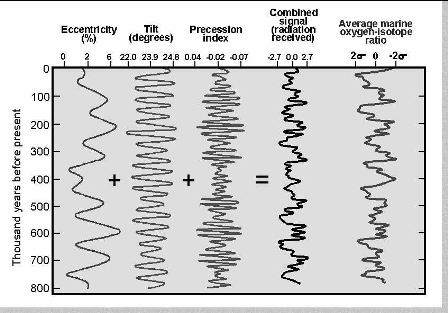
The above figure shows the graphs of these 3 types of phenomena with their periods of 100.000, 40.000 and 22.000 years. The fourth diagram from the left shows their cumulative effect on the amount of radiation received by Earth.
This theory evoked considerable interest, but it was criticized because it did not account adequately for the differences in the climate records between the two terrestrial hemispheres.
The English astronomer Sir Fred Hoyle proposed a theory attributing the cause of ice ages to the impact of very large stone meteorites. These would have raised huge amasses of dust which would have shielded the sun for about ten years. The lower temperatures would have caused the freezing of the humidity in the air forming minute ice needles (termed diamond dust) which would reflect solar radiation so keeping the temperature low for millennia Ice ages would end as a consequence of the impact of a very large metallic meteorite. Metal particles in the atmosphere would absorb the solar radiation and cause the temperature to increase due to their low specific heat. Diamond dust would melt and an interglacial era would begin.
Hoyle's theory was abandoned, whereas, in the Seventies, Milankovitch's was confirmed by numerous findings. These were based on the analysis of ice carrots extracted from depths of many kilometers in Antarctica by the Vostok mission. The depths at which the samples are taken indicates their age. Analyzing air bubbles contained in the samples it is possible to determine the percentage of atmospheric CO2 in remote epochs. The average temperature of the atmosphere when the air bubbles were caught in the ice is computed on the basis of the values of the ratio between the quantities of the two oxygen isotopes 18O and 16O.
The diagrams in the following figure represent the variations of air temperatures with respect to present day averages (blue curve), the proportion of CO2 in ppm (green curve) and the quantity of dust in the atmosphere (red curve). The first two diagrams essentially coincide with Milankovitch's calculations of solar radiation reaching the Earth's surface determined on the basis of processing astronomic data.
The conclusion is that temperature variations are determined by periodic regularities of the position and the motion of Earth. Hence it is temperature variations which cause changes in the percentage of atmospheric CO2 and not the reverse. The increased greenhouse effect is noyt the cause of global warming. It is the temperature increase which causes the growth of the CO2 atmospheric content - which THEN in turn contributes to the temperature increase.
Source: www.ngdc.noaa.gov/paleo/icecore/antarctica/vostok/vostok_data.html
But, then, what is the basis for the current opinion that human activities are responsible for modifying the composition of the atmosphere and for causing global warming?
At present the CO2 content of the atmoshere grows on the average by 1,6 ppm per year, which corresponds to 3,3 Gt/year. It is a considerable growth and I analyze it below. Where does this carbon dioxide come from? There are two considerable sources which are fairly easy to measure:

So: the average yearly increase of atmospheric CO2 constitutes slightly less than half of the carbon dioxide entering the atmosphere due to human activities. The question:
"Where does the rest go?"
is wrong. Just as in bookkeeping, we cannot compute these balances by difference. In fact there are other sources as well as other sinks of CO2. We have to consider all the ways in which carbon dioxide is stored in our planet. Authoritative texts (e.g.: Guido Visconti, L'atmosfera, Garzanti, 1989) indicate that carbon present in the atmosphere as CO2 weighs 800 billion tons. The biosphere (trees and plants) contains 2.000 billion tons and the oceans 37.000. It is reasonable to think that the oceans predominate in any connected process - on the basis of mechanisms which have not been completely understood (see Lai, C.C. et al - Topics in Catalysis, Kluwer Academic, 2005).
L.C. Smith and others have published (SCIENCE, Vol.303, 16/1/2004) a paper on the mechanisms by which the huge deposits of peat in Northern Russia absorb carbon and eventually emit methane. Just one of these extends for 600.000 km2 (an area double that of Italy) and, depending on temperature absorbs or emits huge quantities of methane and of CO2. It is not known how much carbon is contained in these deposits whcih were formed during the holocene, that is in the last 12.000 years. Estimates vary between 270 and 1050 Gt. The absorption of CO2 and the emission of methane appear to vary depending on temperature: the quantities involved are so large to exceed by far those appearing in the calculations on the previous page. The impact of all human activities appears, then to be largely irrelevant.
An objection could be raised to the conclusion that temperature variations and hence changes in atmospheric carbon dioxide content are caused predominantly by astronomic events. In fact the last diagram certainly shows a correlation of just about 100% between temperature and CO2, but the periods are not constant as we would expect in a sequence of events which has astronomic causes. The time intervals between maxima of temperature (listed in the following table) going back from the present time are of 130.000, 120.000, 95.000 and 85.000 years.
[Incidentally it appears that the current temperature maximum has not yet been reached, so that we may expect a further increase of atmospheric temperature just on the basis of paleoclimatic evidence.]

If we consider, though, intervals between temperature minima, we can see that they are longer and that the period of 100.000 years falls every time within the periodic variation. Consequently the Fourier analysis of the diagrams shows a 100,000 years period and the repetition of glacial and interglacial eras depends essentially on the concomitant impact of the factors singled out by Milankovitch.
The waveform of the process is deformed by a number of factors. The increase of the carbon dioxide content (due to the increase of temperature) does cause a stronger greenhouse effect which amplifies the warming. A similar effect is due to the decrease of the albedo since ice areas decrease in size and reflect towards space lesser amounts of solar radiation. There is, then, a strong positive feedback, which explains why temperature rises at the end of ice ages are so steep.
Other factors play also a role. Among these solar activity (sunspots variations, etc.) and, over the long term, continental drift. Over the short term, a marked effect is due to the atmospheric obfuscation caused by large volcanic eruptions. For example a general temperature decrease was attributed to the Piñatubo eruption.
Recent history - after the last glaciation and the last 1000 years
There were important glaciations 700, 400 and 4 million years ago, when homo sapiens did not exist. According to Peter Ward of Washington University, there was, instead, a massive global warming 250 million years ago, which led in the course of a few million years to the extinction of 90% of marine species and of 75% of terrestrial ones. It appears that this tragic occurrence was caused by huge volcanic eruptions in Siberia jointly with geological events which produced a lowering of the sea level. Exposed areas of the sea bottom emitted, then, large quantities of methane - the most effective contributor to the greenhouse effect. At present conditions are very different so that those remote events are not very relevant for us.
It is quite remarkable, instead, that 20,000 years Canada and Northern Europe were covered with a 2,000 meters thick layer of ice. Temperatures were low also in Southern regions. The following diagram shows the increases of temperature (of about 8°K) and of carbon dioxide (of about 100 parts per million) during the last twenty millennia.
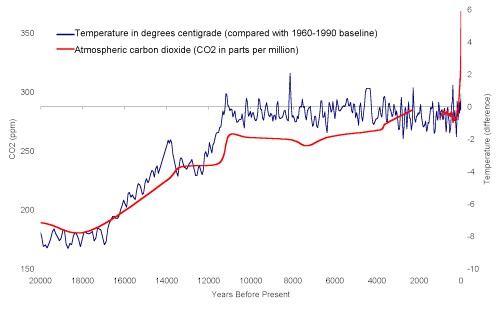
This process too was analyzed by Milankovitch. The temperature increased very fast. Neanderthal and homo sapiens had already appeared before the end of the last ice age, at which time in the African savannas our ancestors evolved reaching our present form. Those primitive men survived notwithstanding the scarcity of resources, their minimal knowledge and their rudimentary technology.
If the temperature had not increased, none of the great human civilizations would have evolved. Only when the 21°C isotherm moved North, around it were born the civilizations of Mohenjodaro (between India and Persia), of Persepolis, Babylon, Egypt and then those of Phoenicians, Greeks, Romans. And at the same time were born the Chinese civilization and the premised for American pre-Colombian ones. Then were created: agriculture, cities, technologies, arts, science and all the factors that have increased human power and resources. Since then men lives have left traces. They have produced interesting events, remembered after millennia and imposing artifacts many of which still exist. Men also waged wars, caused tragedies, destructions, genocides. Still things are not so bad: we are much better off than our hunter and gatherers ancestors.
Certain tragic events in history probably had climatic causes. The disappearance of the great Mayan kingdoms was caused, perhaps, by a long period of drought from the 8th to the 14th century. According to some, climate changes caused by a decrease in sunspots lowered the temperature of the Northern Atlantic Ocean producing the mini Iceage from the 15th to the 17th century: Greenland was abandoned, Iceland had only one harbor free of ice and the islanders were about to leave it and go back to Denmark. Then the temperature went up again around 1700 - and at that time nobody burnt fossil fuels: a clear sign that the impact of industrial activities has been overestimated.
The following figure shows the variations of atmospheric temperature according to six reconstructions worked out by separate groups of scientists. They all confirm the occurrence of a worm period between 800 and 1300 and of the following mini ice age which lasted until the end
of the 17th century.
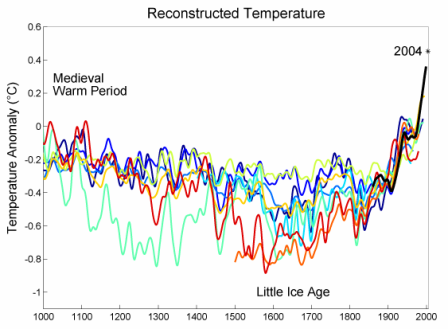
This trend is confirmed by measurements taken in the last 150 years (see following figure).
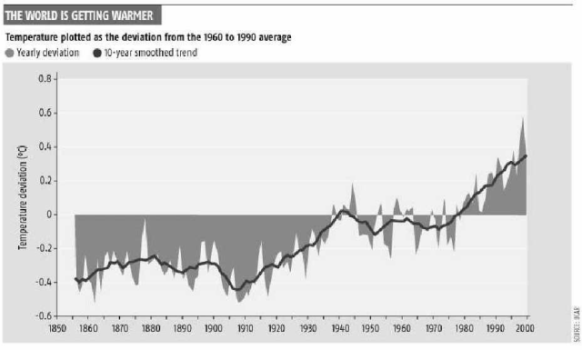
The diagram shows the cooling down - or the absence of large variations - after 1900 and we notice a modest temperature decrease after the eruption of Piñatubo already referred to.
My own mathematical forecast - empirical, but accurate
In the last 4 decades the concentration of atmospheric CO2 measured in MaunaLoa by C.D.Keeling and T.P. Whorf of Scripps Institute of Oceanography, University of California, increased continuously. This is well known. Less known is the fact that in 1976 a discontinuity in this process took place. The average yearly increase of the atmospheric carbon dioxide content between 1959 and 1976 was of 0,95 ppm/year. Instead between 1976 and 2003 the average increase was of 1,608 ppm/year. This acceleration of the process has been interpreted by some as an indicator that the phenomenon is gaining momentum and that, therefore, we will soon witness the feared doubling of atmospheric CO2. This, however, is a naive forecast based on simplistic extrapolation. I have worked out the equations which best describe the time series 1958-76 and 1976-2003. I have used the 3 variables Volterra logistic equations of the type:
x = A/[1 + e(B t + C)]
These equations describe accurately growth processes of certain variables (biologic populations, epidemics, industrial products) that grow and aim to fill an ecological niche. The corresponding diagrams are S shaped, where growth is initially slow then becomes so fast as to appear exponential. Then the impact of limiting factors is felt: the growth slows down and aims at a constant asymptote.
The following table shows the data measured in MaunaLoa.
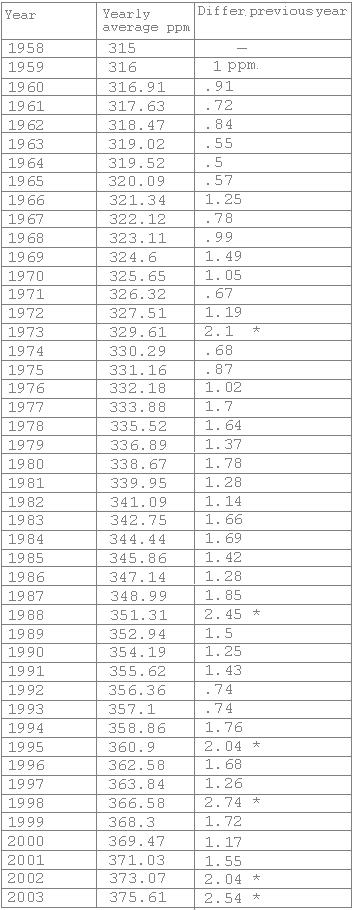
The standard error is the square root of the sum of squares of the differences between computed and measured values, divided by the average of all values.
The following table gives the parameters of the two equations and also the results obtained. The time constant is the time to go from 10% to 90% of the final asymptote.

This analysis indicates that from 1976 the atmospheric CO2 concentration is increasing faster than in previous years towards the lower asymptote of 424 ppm which should be reached in the first decades of the 22nd century (see diagram).
The 2 very low standard errors in the equations' fits, indicate that the analysis is credible. If future observations confirm that the current trend aims at the 424 ppm asymptote (13% higher than the 2003 level), dangers of global warming due to increases of atmospheric CO2 would be assessed as much lower than judged by some or as non existent.
In the third column of the table the difference is given between each year and the previous one. This exceeds 2 ppm in 1973, 1988, 1995, 1998, 2002 and 2003. It has been suggested that this indicates a further increase of the rate. Whether this is so will appear in the next few years. A correlation with the ENSO (El Niño Southern Oscillation) appears unlikely since strong El Niño phenomena appeared in 1973, 1983, 1993 and 1998 -- so: only in 2 years (but not in 4 others) there was an increase of more than 2 ppm AND strong ENSO.
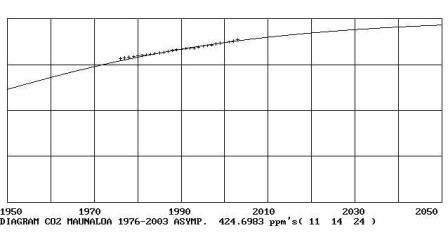
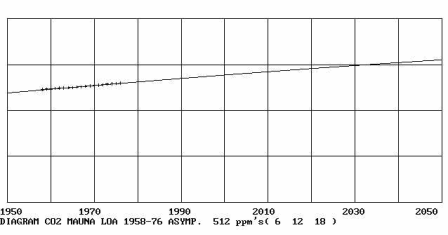 Remedies
It is not reasonable, then to think that humans are causing severe and irreversible damage to the environment because they burn fossil fuels. We are not producing a global warming on a planetary scale.
Remedies
It is not reasonable, then to think that humans are causing severe and irreversible damage to the environment because they burn fossil fuels. We are not producing a global warming on a planetary scale.
Another theory, recently publicized by some, sounds even less reasonable. It asserts that humans began to cause global warming many thousand years ago as the first farmers began to destroy forests burn plants, flood fields for planting rice, raise cattle. In those remote times, in fact, the globe's human population was so small that it makes no sense to argue it could have had global impacts on the climate.
In any case, when issues were less clear than they are now, some physicists advocated remedies against the possible risk represented by the increase of atmospheric CO2.
 Freeman Dyson proposed to plant one thousand billion sycamore trees. If we suppose that each tree at full growth can store 500 kg of carbon, the total quantity would be of 500 Gt (billion tons) or about 60% of the amount present in the atmosphere in the form of CO2.
Freeman Dyson proposed to plant one thousand billion sycamore trees. If we suppose that each tree at full growth can store 500 kg of carbon, the total quantity would be of 500 Gt (billion tons) or about 60% of the amount present in the atmosphere in the form of CO2.
 Cesare Marchetti suggested ["How to Solve the CO2 Problem Without Tears" - 7th Conference on hydrogen, Moscow 1988] to centralize the production of CO2 using nuclear energy in the Russian steppes to reform natural gas, extracting hydrogen to be used as an energy vector. The CO2 produced would then be liquefied and sunk in the depth of the oceans or else in exhausted oil wells. The latter solution would also permit to recuperate residuals of oil in the wells. The CO2 stored underground could also be released again in the atmosphere to enhance the greenhouse effect and raise the temperature, in case a new ice age appeared to be imminent.
Cesare Marchetti suggested ["How to Solve the CO2 Problem Without Tears" - 7th Conference on hydrogen, Moscow 1988] to centralize the production of CO2 using nuclear energy in the Russian steppes to reform natural gas, extracting hydrogen to be used as an energy vector. The CO2 produced would then be liquefied and sunk in the depth of the oceans or else in exhausted oil wells. The latter solution would also permit to recuperate residuals of oil in the wells. The CO2 stored underground could also be released again in the atmosphere to enhance the greenhouse effect and raise the temperature, in case a new ice age appeared to be imminent.
 One measure that should certainly be adopted consists in developing alternative energy sources thus avoiding to burn fossil fuels. Among these: high efficiency solar photovoltaic: theoretically efficiency could be raised from present day 15% to 85%. Even if burning oil and natural gas is not really causing dangerous impacts on the climate, those resources are vital for the petrochemical and plastic industries with a usefulness far greater than that achieved by burning them.
One measure that should certainly be adopted consists in developing alternative energy sources thus avoiding to burn fossil fuels. Among these: high efficiency solar photovoltaic: theoretically efficiency could be raised from present day 15% to 85%. Even if burning oil and natural gas is not really causing dangerous impacts on the climate, those resources are vital for the petrochemical and plastic industries with a usefulness far greater than that achieved by burning them.
Uncertainties
In conclusion there are many processes and situations which have an impact on climate. There are astronomical events, biological processes (billions of years ago cyanobacteria decomposed water molecules absorbing hydrogen and releasing the oxygen which formed the atmosphere), impacts of meteorites, volcanic eruptions, sun spots. Experts have understood many things, but not everything. Consequently we are not able yet to produce accurate long term climate forecasts.
I have asked .Guido Visconti, professor of terrestrial physics at the University of L'Aquila (Italy) for an opinion. He answered:
"At present the main problems to be solved are:
1. What is precisely the causal mechanism of glaciations?
2. What is the cause of the phase variations of CO2, temperature, methane, etc
As regards (1) it would appear that Milankovich was right except for the fact that the dominant period of 100.000 years actually corresponds to the eccentricity variations of the terrestrial orbit. These variazioni, though, appear to be too small. Also the other factors with a period of 40.000 years (inclination of the terrestrial axis) and 22.000 years (precession of equinoxes) are small. Hence we have to think of an amplifier effect which at present has not yet been defined completely.
As regards (20,0n the past we thought of a biological pump (if the level of the oceans is lowered, we have an increase of erosion conditioned fertilization, which enhances biological activities apt to absorb CO2). In fact at present we are thinking more of a fertilization from the sky, since a frozen earth has much more dust in its atmosphere."
And if, instead, a new ice age was imminet? Atsumu Ohmura is a geographer and he works fir the Swiss Federal Polytechnic (ETH). In 1985 he analyzed the time series of the solar radiation recorded in the last 30 years - and he was flabbergasted: it was decreasing of 0,3 per year. In thirty years it has gone down by 10%. tre decenni era calata del 10%. Ohmura hesitated 4 years before publishing his results. When he did, he was ignored.
Other researchers too had expressed the opinion that sunlight on eartha tended to decrease in the last two decades of last century. Stanhill and Shabtai Cohen (of the Volcani Center in Bet Dagan, Israel) contended they had proved that solar radiation reaching Earth has gone down from 1958 to 1992 of an amount between 0,23 and 0,32% per year.
These resukts were taken seriously by Graham Farquhar, an Australian biologist at the University of Canberra, who studied radiation decrease as measured at ground level. When Farquhar mentioned the issue to a famous unnamed expert, the latter answered:
"That's bullshit, Graham. If that was the case then we'd all be freezing to death."
A lot of controversy ensued. An article by Farquhar was accepted in 2002 by the magazine Science . It appears that the diminution of radiation takes place in the visible spectrum and in the infrared - not in the ultraviolet. Other experts maintain, on the contrary, that solar radiation increased in the last 15t0 years. How do these contrasting observations check with the increase in atmospheric temperature which has been taking place for 3 centuries and which has been the basis for the current global warming panic?
According to the latter researcher quoted, diffused solar radiation does not damage the flora and perhaps is good for it. Dome say that temperature goes up, while light goes down. Controversies have no end.
A well known huge factor influencing climate is the energy carried by oceanic currents. It is thousands of times larger than all the energy produced by humans. It is well known that due to the Gulf Stream. Northern Europe has a much milder climate than the Atlantic regions of Canada and of the USA, at the same latitude. The balance of these large currents is also influenced by the continental drift - a well known, very slkow process.
A worrisome forecast has been published by Peter Wadhams, professor of oceanic physics at the University of Cambridge and head of the group studying the physics of polar oceans. After campaigns of observations in Greenland and under the North Pole (in a British submarine) thus scientist maintains he has measured a thinning of the Arctic icecap of 45% and a marked decrease of the vertical cold currents coming from the Pole and descending toi depth of 3000 meters. Said currents used to attract on the surface the warm water of the Gilf Stream much more strongly than is the case now. Consequently Wadhams considers it probable that by 2020 the Arctic icecap will melt completely. He gives this event as certain by 2080, after which year the temperature of the British Isles would decrease by about 10°C.
These verdicts do not sound very credible, even if the author is a well known expert. I think that we should be modest - and wary to accept gratuitous certainties. Certainly it is good to cultivate imagination, which is the basis of progress and of scientific invention and supplies the concepts at the foundations of any mental or mathematical model. The latter, though, have to be used cautiously - even if they are quite impressive as they evolve very fast on our computers. They can hardly give certainties until they are validated - and we have yet no validations in long term climate studies. No model has forecast accurately future events dozens of years in advance. Let us keep in mind the teaching of Galileo Galilei:
"What our experience and our senses show to us must prevail over any discourse, even if it sounds very meaningful." -"Ciò che l'esperienza e i sensi ne dimostrano devesi anteporre a ogni discorso ancorchè ne paresse assai fondato ."